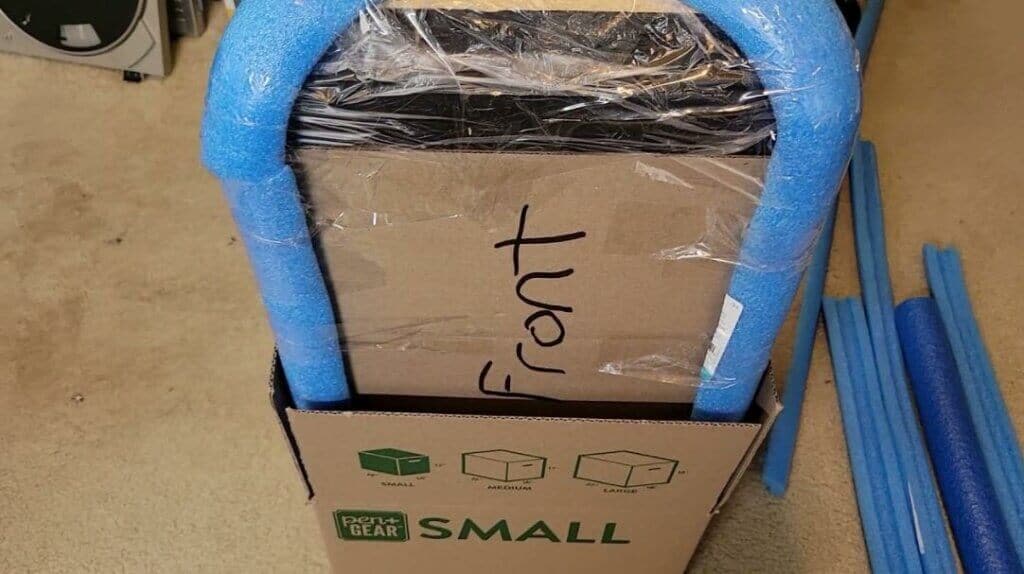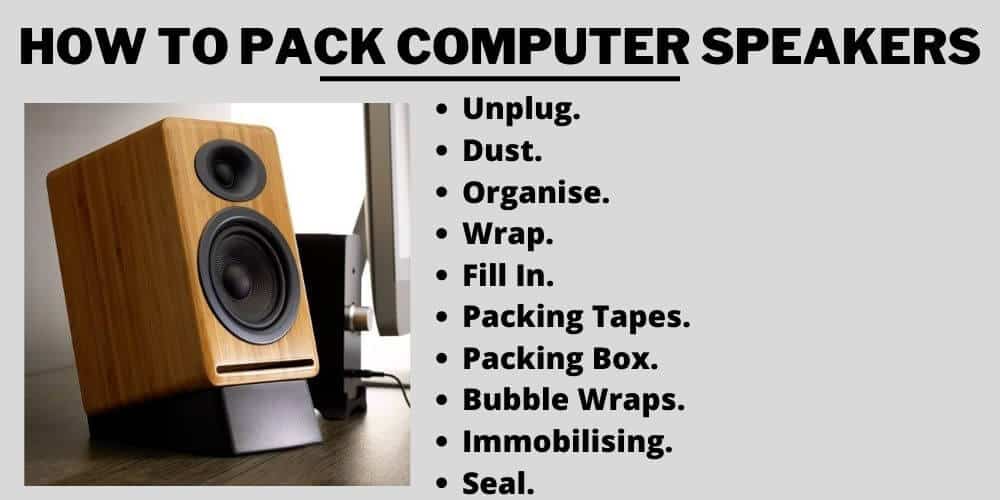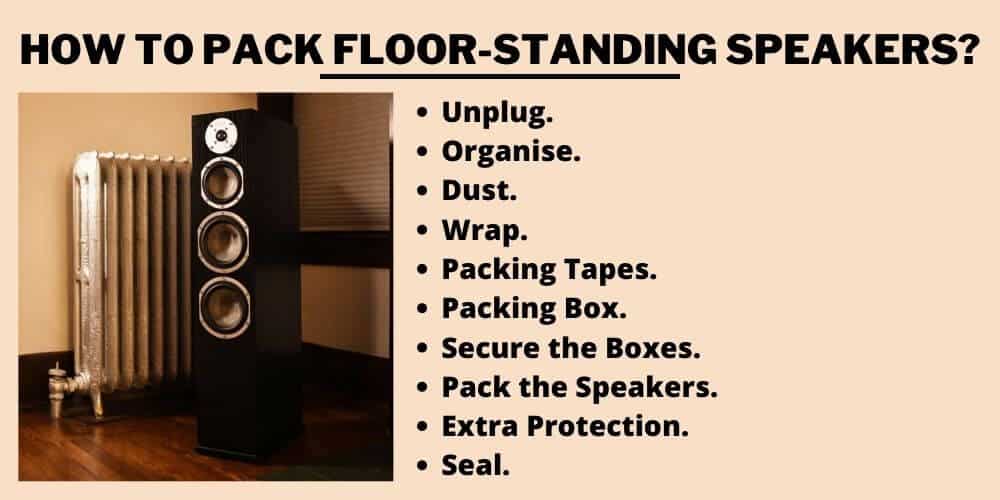Speakers can be a real challenge to pack and ship, especially if they are large and more so if you don’t have the original packaging. Expensive and sensitive as they are, speakers need special attention during packing.
It’s very important to know how to ship large speakers correctly, because even a small mishap can lead to permanent damage and a huge loss.
One more thing I would like to add here is that it’s equally important to learn how to pack large speakers before actually shipping them. Actually, musical instruments like Guitars, Piano, Ukelele etc. require special attention while packaging.

Simply relying on original packaging or courier companies hired for shipping can turn out to be a risky business. Instead, it’s better to take matters solely into your hands and learn to pack them with utmost care.
And this is the reason why we are here with this article to guide you through the process of packing and shipping large speakers.
We are sure that once you finish the lesson of how to ship large speakers, you will be a pro and have no trouble handling the shipping business. So, join in to learn the step-by-step procedures to pack and ship large speakers.
Let’s go!
Table of Contents
Types of Large Speakers

Before learning how to ship large speakers, you must know about the types of them. There are many kinds of speakers. However, large speakers are usually of two kinds:
Computer speakers are the ones that come with desktop computers and are usually large but vary in size and quality. These are used to play simple computer sounds while playing games, watching a movie, listening to music, etc.
As the name suggests, floor-standing speakers are large, heavy and tall enough to sit on the floor. They are usually used for home theatres, high-end gaming, high-quality videos and the like.
As it’s apparent from the definition, floor-standing speakers are far more sophisticated than computer speakers. And hence, they are much harder to pack and ship. There are several reasons why it can be a little tricky to pack floor-standing speakers:
How to Ship Large Speakers with Right Packaging (Both Types)
Here comes the most vital part of shipping large speakers—the packaging! Shipping is easy if you know how to pack. So, you must learn the trick.
There might be numerous variants of floor-standing or computer speakers, depending on their shape, size, quality, capacity, manufacturer, etc. But no matter what, their core features are more or less similar. And hence, the packing techniques to are almost the same for both types.
So, you don’t have to worry about which particular speaker you use. You can simply identify its exact type-whether it’s a computer speaker or floor- standing speaker—and then continue with the following methods of packaging.
How to Pack Computer Speakers
Here are the steps to safely pack computer speakers:

Step 1: Unplug
Carefully unplug the speaker from the power supply and unhook it from the computer if they were previously in use. You can also consider taking a photograph before disconnecting to keep a record of exactly how it was Connected to the computer. You can use it later while reconnecting it with the computer.
Step 2: Dust
If the speakers were previously used, they may require some good dusting. This will prevent dust from accumulating on the speakers and damaging them while packed inside the box.
Step 3: Organise
The next step is to arrange the cables of the sound system and keep them organised with cable ties or large rubber bands. This will ensure the safety of the cables once packed.
Step 4: Wrap
Wrap each speaker individually in soft packing paper or the sturdier brown craft paper.
Step 5: Fill In
Fill the insides with bits of packing paper or bubble wraps to ensure double protection and prevent the harm caused by any jolts or jerks during transportation.
Step 6: Packing Tapes
Secure the outside with high-quality packing tapes to prevent them from unwrapping during the journey.
Step 7: Packing Box
Find the original box of the speakers, or at least find another box similar to the original one that would fit the speakers comfortably. Ensure that the box has clean, sturdy cardboard that won’t succumb to pressure.
Step 8: Bubble Wraps
To enhance protection, add some extra layers of bubble wraps outside the speakers before inserting them into the box.
Step 9: Immobilising
To immobilise the speakers, use bubble wraps, crumpled paper or packing peanuts to fill in any holes or gaps left within the shipping box after packing the speakers inside.
Step 10: Seal
Seal the box with double layers of packing tape and put proper labels. Mention the words “FAGILE” and “HANDLE WITH CARE” on the box to warn the ones handling the shipment at the courier company.
How to Pack Floor-Standing Speakers
Here are the steps to pack floor-standing speakers with utmost care:

Step 1: Unplug
Unplug the sound system, disconnect the speakers, and remove all the cables. But before that, you might consider photographing the setup to reconnect them later.
Step 2: Organise
Organise the cables and arrange them neatly using elastic rubber bands or cable ties.
Step 3: Dust
If the speakers were previously in use and had accumulated dust, it’s advisable to dust and clean them first before putting them down in boxes. Use a damp cloth to wipe off the dust and soft paper tissues to dry them later.
Step 4: Wrap
Wrap the speakers with wrapping papers and bubble wraps. Soft, clean, ink-free and acid-free packing paper is enough to provide the first layer of protection. Use large sheets of bubble wraps with large bubbles for the second layer of protection around the packing paper.
Ensure that you use the soft packing papers as the initial layer under the bubble wraps to prevent the delicate finish of the speakers from being stained by the plastic wraps pressed too hard against their sensitive surface.
Step 5: Packing Tapes
Secure both the layers with good-quality packing tapes to prevent them from unwrapping during the journey. Ensure that the packing tape doesn’t come in direct contact with the surface of the speakers; else, it may damage its lacquered finish.
Step 6: Packing Box
The next big step is finding the perfect box to pack the speakers. If you have the original box that the speaker came in; there is no reason to look anywhere else—they will protect the speakers in the best possible way.
Otherwise, you will have to look for large, sturdy, clean boxes slightly larger than the speakers. You will need two separate boxes of the same kind for the speakers to be packed individually, and don’t try to pack both.
the speakers into the same box as it’s liable to cause some severe damage. To secure the boxes, you can contact the speakers’ manufacturers or the electronic stores in your locality.
You can also find certain online sites that sell packing boxes. No matter where you buy the boxes, ensure they are of the right size.
Step 7: Secure the Boxes
Once you get your hands on the packing boxes, secure their bottom and sides with brown tapes. Place a few sheets of bubble wraps inside the boxes to serve as a cushion for the speakers.
Step 8: Pack the Speakers
Carefully slide the speakers into the boxes and see if it fits perfectly. If there are gaps left; use some more bubble wraps or pieces of crumpled papers or packing peanuts to cover them up to prevent the speakers from sliding around inside the boxes.
Step 9: Extra Protection
The next step is to use extra protection for the most fragile part of the speakers—the front where the drivers are located. You need to insert a long piece of Styrofoam inside the box and set it between the front of the speaker and the side of the cardboard.
To ensure that the delicate cones are not accidentally punctured or pushed in, the piece of Styrofoam needs to match the length and width of the packing box.
Step 10: Seal
The last step is to seal the box with double layers of packing tapes. Label the boxes and write “FAGILE” and “THIS SIDE UP” on the side of the drivers so that the carriers at the courier company know that they had to be handled with care.
Conclusion
Large Speakers don’t make it any easier for you to pack, ship and deliver. But that shouldn’t stop you from shipping them across borders. All you need to do is pack them with utmost care and ship them to a reliable courier company that you can trust.
This step-by-step guide on how to ship large speakers endeavors to provide all the information needed to muster the confidence of shipping large speakers fearlessly. So, just ship away!